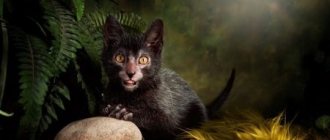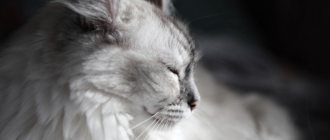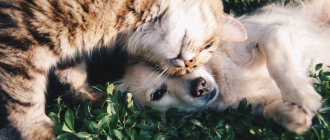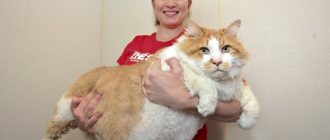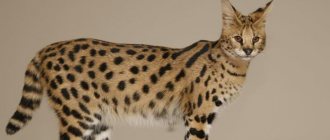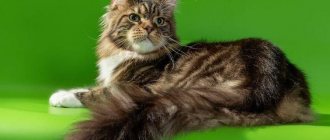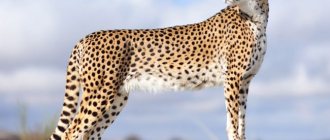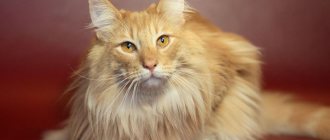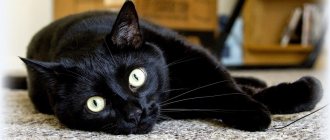- Cats
- General issues
Domestic cats are the most popular pets for modern city dwellers. Living side by side with furry creatures, you involuntarily begin to wonder what the origin of cats is, where these graceful and unique animals came from, what part of the world can be considered the homeland of mustachioed pets. Of particular interest are the issues of domestication and taming of the wild counterparts of modern furry beauties.
BC
The first mammals, among which predators also appeared, were creodonts. About 75 million years ago, this group of animals was very numerous, and included various species of omnivores and scavengers. About 50 million years ago, the miacids evolved from the creodonts. These were animals with more developed intelligence than their predecessors. Externally, the miacid resembled an ermine or a weasel - an elongated body and head, short legs, a long tail and a flexible spine. Cats appeared about 40 million years ago, when the evolution of miacids took two paths. The first group of animals is considered the ancestors of all canines. Representatives of the Viverravines group may have been the ancient ancestors of modern cats. Fossa, a unique animal from the island of Madagascar, according to some scientists, is a transitional form of prehistoric viverrids to representatives of the felines.
The appearance of cats is often associated with proailurus. This extinct animal was a very nimble and fast, flexible and ruthless hunter. He spent most of his time in the trees, descending from the branches only in search of prey. Interestingly, prehistoric cats changed little compared to other animal species: during evolution, the size of the brain increased, the muzzle became shorter, and the limbs became slightly longer. About 140 thousand years ago, the steppe cat appeared - one of the subspecies of the forest wild cat. The steppe, African or spotted cat still lives in the desert, mountain and steppe regions of Asia, Africa, India, Kazakhstan and Transcaucasia. These are small animals weighing up to 7 kg, wearing striped coats of a sandy-grayish color.
The appearance of the domestic cat is associated precisely with its closest “steppe” relative. Previously, it was believed that the ancestors of domestic cats were also representatives of other species of small cats - sand cats, European forest cats, and jungle cats. However, recent genetic studies refute this theory.
Scientific approach
Scientists have an informed view of the data on when cats appeared on earth. Evidence has survived to this day that the descendants of furry pets appeared on our planet about 60 million years ago. It was during this period that migration processes of mammals, including small predators, took place on Earth.
Fossa An ancient resident of Madagascar, the Fossa is considered by many scientists to be a prehistoric representative of the cat family.
Researchers in the field of evolutionary zoology believe that the ancestor of the modern cat, Proaiurus, weighed about 9 kg and resembled a marten. About 20 million years ago, Pseudolurus, an excellent tree-climbing animal, appeared. The small predator was a clever and successful hunter.
This prehistoric animal gave rise to two directions in the evolutionary process - modern representatives of the feline genus and ancient saber-toothed cats.
According to the research of modern science, the lion is the youngest of all representatives of its large family . Animals such as lynx, puma and leopard are older than the king of beasts in historical terms. Inhabiting the territory of Eurasia, Africa and America, about 10 thousand years ago saber-toothed cats became extinct, leaving for the further evolutionary process only the branch that gave rise to the modern cat species.
Zoological scientists suggest that the historical roots of domestic beauties are of African origin. The North African steppe cat is the one from which cats originated. She is the closest relative of the pet that modern people are used to seeing at home.
The African cat had a spotted (brown) color and was not as aggressive as other subspecies. The dun ancestor was distributed throughout the African continent.
The anatomical and morphological characteristics of these ancient animals are similar to the structure of the skeleton and internal organs of modern pets. The savanna relative was domesticated approximately 8 thousand years ago in Nubia (the territory of modern Northern Sudan).
Many scientists believe that the founder of the modern feline species is the Asian cat, which is widespread in Arabia and Mesopotamia. This theory is supported by the morphological similarity of the Pallas' cat and the Persian cat.
Most pundits are inclined to the theory that both the African and Asian subspecies of cats are the progenitors of modern furry beauties. This polyphelic origin indicates that the rocks originated in several historical centers of the Earth, independently of each other.
In Asia, crossbreeding with the Bengal cat took place; in Europe, the European forest cat participated in the formation of breeds. It was thanks to such local crossings that breeds varied in color, thickness of coat, and constitution began to appear. This is evidenced by numerous genetic studies of cat populations.
In addition to scientific theories on the topic of where cats came from on earth, there are also absolutely fantastic versions regarding this issue. Some owners seriously believe in the alien origin of their furry beauties. About the history of cats in Ancient Egypt, watch this video:
[custom_ads_shortcode3]
The appearance of cats in Rus'
Excavations carried out in Russia and the former Soviet Union have shown that cats appeared on our lands in the seventh century. But the first descriptions of these animals are in documents dating back to the eleventh century. It is assumed that foreign sailors brought strange animals to Russia and sold them for huge sums of money. People liked this creature, because its eyes glow in the dark, and from any height it falls on all four paws, and even purrs! Over time, the cats began to breed and multiply, and now in the peasant huts the beast caught mice and rats, protecting the owner's supplies. There is a legend that Peter the Great himself adored these creatures and, seeing how another cook was chasing a fluffy one, declared cats to be inviolable creatures. You may ask, why does a chef need a cat? This animal simply brought him a dead rat as proof of its work and irreplaceability and placed it on the cutting table. That's all. But since then no one could offend the tailed one in Rus'.
How and when the cat was tamed
The question of dating the domestication of cats has long been of interest to scientists. Most of them agree that this happened simultaneously with the development of animal husbandry and agriculture. People no longer had to spend whole days getting food; moreover, there was a surplus of food. The problem of ensuring their safety immediately arose: food warehouses became places of pilgrimage for rodents, which not only completely destroyed supplies, dooming people to starvation, but also spread diseases that decimated the population of villages and cities.
Cats that came to human homes and hunted rodents became a real salvation. There is only one problem left to solve: to ensure that cats live with people permanently. This was not easy to do due to the freedom-loving nature of these animals, therefore, according to one version, people tracked down wild cats, took their offspring and tried to tame the kittens.
According to another version, great credit for the domestication of cats belongs to the ancient Egyptians, who not only treated these animals kindly, but also deified them. The status of a cat in Ancient Egypt was hardly lower than the status of the pharaohs themselves; it was impossible to imagine not only killing an animal, but also causing the slightest harm to it. Such actions were punishable by death. Cats lived at temples and in the houses of the nobility, after death the animals were mummified and buried with great honors, the owners shaved off their eyebrows as a sign of grief, and mourning for a pet lasted the same amount as for a person - 70 days.
In China, cats lived next to humans more than five thousand years ago. This was confirmed by radiocarbon dating of animal remains discovered at the archaeological site of the village of Kuahukun. Cats were loved and revered in China no less than in Egypt. These animals were valued not only for their hunting qualities, but also for their loyalty.
In Europe, attitudes towards cats were not so unequivocally positive. In Ancient Greece and Ancient Rome, these animals were loved, although they were not deified, as in Egypt. In other European countries, cats are much less fortunate. At first they were considered valuable animals. In England in the 10th century. a mouse cat was more expensive than a lamb, and the rules for keeping these animals were regulated by royal decree. The ancient Scandinavians believed that cats belonged to Freya, the goddess of love and fertility, and the priestesses of the goddess had the right to put to death anyone who harmed a cat.
- Urban dog breeds
- Origin of the cat
- Hypoallergenic dogs
- Fighting dog breeds
- The rarest cat breeds
- German Shepherd
In the Middle Ages, attitudes towards cats changed radically. If previously mysterious and mystical properties were simply attributed to them, now these animals were declared by the Church to be accomplices of the devil. Black cats were especially unlucky; they were considered the embodiment of evil and they believed that witches could turn into them. Cats began to be exterminated en masse, inventing the most sophisticated methods of killing, and those who continued to love the unfortunate animals and kept them at home were tortured and burned at the stake as sorcerers. As a result of the actions of the Inquisition in Europe, 90% of the cat population was destroyed, for which people soon paid dearly. The rats that bred in huge numbers and the fleas that lived on them contributed to the outbreak of the bubonic plague epidemic, from which, according to various estimates, from a quarter to half of the population of Europe died in the 14th century.
Only in the 17th century. superstitions towards cats began to fade into the background, and these animals again began to win the respect and love of people.
People of royal blood did not hesitate to keep cats at court; they were pampered and cared for in every possible way and were even given fortunes. Around the same time, work began on creating new breeds.
In Rus', cats were never subjected to such persecution as in Europe; moreover, it was believed that they bring happiness and prosperity; it was not for nothing that when entering a new house, the cat was the first to be allowed into it. These animals are the only ones allowed to be in Orthodox churches; in many old churches they even had manholes made for them.
For a long time in Rus', cats were very expensive, so not everyone could afford them. In Kazan, it was customary to place the most well-groomed cats in the windows of merchant shops: the fatness of the animal was supposed to show that its owner was doing well. It was Kazan cats that were brought by decree of Empress Elizaveta Petrovna to St. Petersburg to protect the chambers from mice and rats. Their descendants are still in the service of the Hermitage and protect the museum property from rodents.
The most common cat diseases
global $ads_google; //data-ad-slot=”2475549904″ $ads_google = empty($ads_google) ? false : true; ?> if ($ads_google == false) {?> $ads_google = true; ?> } ?>
- Flea dermatitis - if a cat has fleas, it will constantly itch and try to chew them out with its teeth, which can lead to damage to the skin. An effective treatment is to treat the animal's fur with flea shampoo or spray.
- Lyme disease is a tick-bite disease, so you need to check your cat regularly and remove ticks.
- Ringworm is a fungal disease that causes bald patches to appear on a cat's body. It is treated with a series of injections of a special vaccine.
- Helminths are intestinal parasites that enter the animal’s body along with food. The cat develops vomiting, fever, and stomach upset. For prevention, you should give your cat antihelminthic drugs twice a year.
All cats are very clean; this is their innate instinct, which is passed on to them by inheritance. Therefore, if you create all the necessary living conditions for your pet, then you will not have any problems with it.
Inhabitants of the Moon or distant stars
Plotinus (a Neoplatonist philosopher) argued that cats came to us from the Moon. They are well oriented in the dark, active at night and their behavior is directly influenced by the phases of the moon.
Augustine the Blessed believed that cats came to us from those distant stars where the human soul goes after death. God showed them the way there and back and gave them the ability to interact with spirits. Have you noticed how cats often and for a long time look into emptiness?
A mysterious origin is attributed to cats, among other things, for their unusual character. No matter where these animals come from, they will always remain our favorite pets. When you feed a stray cat on the street, think about it: what if you are paying tribute to an alien creature?
Modern cat breeds
Eye color, coat color and length, body structure, head and tail, character - all these characteristics are taken into account when creating the breed. The World Cat Federation (WCF) adheres to the following classification of cat breeds:
- long-haired;
- with medium length hair (semi-longhair);
- short-haired;
- Shorthaired Siamese-Oriental.
The International Organization for the Breeding and Selection of New Breeds of Cats (FIFe) uses a slightly different classification:
- exotics and Persians;
- semi-longhaired;
- shorthaired, including Somalia;
- eastern (orientals).
The concept of a “breed” of cats appeared not so long ago. Even 200 years ago, these pets were not classified according to breed characteristics.
It is customary to refer to purebred pets as having certain external characteristics and a unique character.
With the development of breeding work, animals of a certain breed began to be issued documents confirming their belonging and compliance with the standards of this breed. Pets obtained as a result of crossing purebred parents can obtain a pedigree. The document indicates not only parents, but also other ancestors (up to the 4th generation).
There are very few purebred cats all over the world (about 3%), all other pets are classified as mongrel, but this makes them no less revered by humans. Only individuals who do not have breed defects are allowed to participate in exhibitions according to the show class. But individuals without a pedigree are allowed to be shown only in the pet category.
Bible version
Many admirers of affectionate pets know the biblical legend about the appearance of cats on earth on Noah's ark. When the ship Noah built was saving animals from the Flood, rodents appeared on board, which began to pose a real threat to the well-being of the rescued inhabitants of the ark. According to myth, a cat and a cat emerged from the nostrils of a lion when Noah stroked the king of beasts. Thus, the ancestors of modern cats saved humanity and all animals from the invasion of rodents on the ship.
The connection between the domestic cat and its “wild relatives”
Cats can be domestic or wild. The wild cat family includes 37 species; they are considered the most advanced predators of all land animals. These include the puma (America), jaguar (Central and South America), lion (Africa), tiger (Asia), cheetah (Africa and western Asia), snow leopard (Himalayas), lynx (Europe) and others. Large representatives can be dangerous even to humans.
People started breeding new breeds of domestic cats relatively recently - about 150 years ago. There are now more than 100 cat breeds. Among them, the most famous long-haired ones are Persian and Maine Coons; shorthaired - Siamese, British; hairless cats - sphinxes and others.
But so far there are much fewer purebred cats than the usual and beloved “Murok” and “Vasek”. Felines belong to the family of mammals, the order of carnivores. All types of cats have a small head, and a very slender, graceful body. The legs are not high, but powerful. The claws are fully or partially retractable, only the cheetah cannot retract. Most have a long tail, but the lynx has a short tail.
The sizes of cats range from small (20 cm at the withers, for example, domestic cats) to large (120 cm - tiger, lion). The best developed sense organs are hearing and vision. The lifestyle is largely nocturnal and twilight. Food includes fish, birds, reptiles, mammals, and sometimes insects. Most species hunt alone (cheetahs, tigers) or as a whole brood (lions in a pride).
Scientists have found that the tiger and the domestic cat are closest relatives; their common ancestor lived on earth about 11 million years ago. For comparison, the common ancestor of humans and apes lived approximately 12 million years ago. Scientists have concluded that “Tigers are just big domestic cats...” since the differences between the genomes of a tiger and a cat are only 4.4%.

